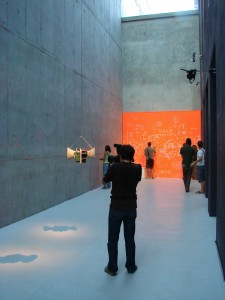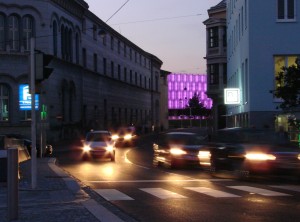The instincts of ARS Electronica Director, Gerfried Stocker, are difficult to argue with. In every era, ARS (set along the Danube in Linz, Austria) seeks to curate, interrogate, and re-deploy an idea as big as the world – in five days or less.The festival is entirely immersive; drawing a global tribe of ‘believers’ and digital nomads into a labyrinth of sensorial and intellectual stimulation. An unlikely cast of non-artistic and non-technological activists, thinkers and visioneers led the charge this year.
Launching headlong into Cultural Economics 2.0, they were staking a claim in the unorganized frontier of the sharing and open-content knowledge economy. In this developing model, trust and transparency, openness and interoperability, crowd sourcing, behavioural economics and collective intelligence are challenging the control of the traditional corporate entity (‘The Firm’). As society, from amateurs’ to the more experienced, access cheap software tools, equipment and distribution, brand control is increasingly being relinquished to consumers. The Beta testing of software for early–stage public feedback, the co-creation of products (Puma shoes, Boeing Business Jet interiors, Nokia cell phones), and the release of what would normally be Digital Rights Management (DRM) controlled content for remixing, are some examples. Large technology companies who participated in ARS 2008 including Vodaphone and Sun Microsystems are ceding to the fact that we would rather use digital tools to express ourselves than we would to consume.
This ‘digital terrain’, while instigating profound cultural change, can have unexpected economic benefit. At the micro level, Renaldo Lemos presented a compelling example from the alternative Brazilian music scene. He described how musicians are appropriating digital technology to build their own networks. For production, recording sessions are organized with DJ’s and Party Producers/Funders, while the CD/DVD pirates in the open markets are used as a primary distribution system. Everything is sold on the street, and new forms of music flourish. Listening to samples of Baile Funk, Kuduro, and Techno Braga, Lemos convinced us of the creative potential of a model foreign to the Universals and EMI’s of this world.
Surveys show that the establishment is catching on to the open-content business model. Radiohead made the cover of Rolling Stone when they released In Rainbows for free (followed by the 6 Stem giveaway of Nude for studio remix). In Atlanta, Georgia, R.E.M. uploads eleven full 240 MB video clips of SupernaturalSuperserious for the Final Cut crowd. NIN launches Ghost I-IV, followed by the full-file distribution of The Slip in 5 formats, including high definition WAVE 24/96 at 1.5 GB. The disclaimer on the NIN website states: “The slip is licensed under a creative commons attribution non-commercial share alike license. We encourage you to remix it, share it with your friends, post it on your blog, play it on your podcast, give it to strangers, etc.©2008 NIN”.
Professionals are mixing it up with amateurs, realising that consumers can be allies who generate feedback and innovation. Feed the birds, I say, feed the birds – to the earliest adopters go the spoils. Corporations and cultural enterprises that acknowledge the ability of amateurs to contribute to product and content development will be positioning themselves to succeed in the sharing economy.
For a window on where we are heading, we need help from people like Christoph Santner of The Future Kitchen, and Philippe Souidi, CScout Trend Director. They led the intense all-day MISSION FUTURE workshop, exploring new kinds of commercialization, crowd-funding, patent law and Creative Commons, social networks, open source code and collaborative working methods.
The balance (or battle) between the protection of intellectual capital and the need for open access in order to promote development and innovation remains unresolved. Patents, while originating as a mechanism to encourage innovation, have been used increasingly as protective strategies to define and defend ‘virtual turf’. In the view of Oswald Schröder (Principal Director of Communication and Change for the European Patent Office), larger corporations file too many patents – creating an enormous backlog – and smaller startups and individuals file too few patents. The session on Patent Law was inconclusive, but it is clear that regulation is not keeping up with innovation. Oswald is working to change this. With few specific proposals on the table, it seems an opportune time for the Cultural Industries to engage the patent system, and this would be worth following up in greater detail at MISSION FUTURE II.
Discussing examples from large corporations like Sun Microsystems (distributors of open source software, including Java, OpenSolaris, OpenSparc, NetBeams, and OpenOffice) to small-cap-start-ups like Sell-a-Band who are using crowd-funding techniques to raise capital for music recording, participants were eager to understand what relevance and value their offerings had, not only in monetary terms, but as denominated in intellectual and social capital. This shift from pure economic gain to community, collaboration, and common good immerged as the most consistent aspiration. The focus is moving to a connect/share/reuse equation where open access and transparency lead to greater interoperability, maximised opportunity, improved awareness, and greater innovation.
A vast array of issues beyond profit and protection present themselves as integral components of open commercial standards. One example is the renewed emphasis on networking and the idea of ‘frienemies’, where corporations compete in some sectors but collaborate in others. The IBM Alliance to produce high-performance, energy-efficient chips at the 32nm process level, with Chartered Semiconductor Manufacturing Ltd., Freescale Inc., Infineon Technologies AG, Samsung Electronics Co., Ltd. (Samsung), STMicroelectronics N.V. and Toshiba Corporation is a powerful example.
Promoting creativity, wisdom, intuition, experience, authenticity, and sociability, the Cultural Economy sessions reaffirmed the legitimacy of artists. The final Digital Music concert in the hallowed Bruchnerhaus sealed the deal. Every performance – tele-virtual [Videobrücke by Sabine Ercklentz, Andrea Neumann (DE)], computational [The Benchmark Consort by Hans. W. Koch (DE)], or interactive [Reactable by Carles Lopez (ES), Sergi Jordà (ES), Günter Geiger (AT), Martin Kaltenbrunner (AT), Marcos Alonso (ES)] was, above all, collaborative, a confirmation of Joichi Ito’s declaration for the artistic imagination that opened the conference. Hans Koch’s declaration on his website is affirming: “I am interested in impredictability (sic) on all levels of a musical work. Besides the creation of open musical forms for various ensembles, mostly including live-electronic and interdisciplinary aspects, I develop installations in mixed media”. His commitment to unpredictability, open forms, interdisciplinary works and mixed media perfectly sums up the artistic attitude that the economic sector is seeking.
At a more intimate level, openness has become mandatory and the members of our new creative society expect holistic thinking, human and collaborative design, social responsibility, customisation and personalisation, relevance, transparency, and (surprise, surprise) joy.
Herbert Enns
Herbert Enns is Director of the Experimental Media Center, a new trans-disciplinary initiative of the University of Manitoba, in Winnipeg Canada. He is a Professor of Architecture, Contributing Editor to Canadian Architect, and Chair of the Editorial Board of MOSAIC: a journal for the interdisciplinary study of literature. He curated Canada’s representation to the 2007 Lisbon Architecture Triennalle titled Alien Space, Strange Places: Canada’s Urban Rivers. EMC projects in development involve collaborations with faculty members in Music, Computer Science, Computer Engineering, Physics and Astronomy, Microbiology, Medicine, and Bio Engineering. He is building a networked and international community of corporate, governmental, and academic collaborators in Australia, the UK, Finland, and the US.
Read More
http://www.thefuturekitchen.net/index.php?option=com_frontpage&Itemid=1
http://www.cscout.com/blog/
http://dl.nin.com/theslip/signup/
http://opensolaris.org/os/
http://www.opensparc.net/
http://www.netbeams.org/
http://www.sellaband.com/
http://www.hans-w-koch.net/
http://www.aec.at/en/festival2008/stream/podcasts.asp
 This work is licensed under a Creative Commons Attribution-NonCommercial-ShareAlike 2.5 Australia.
This work is licensed under a Creative Commons Attribution-NonCommercial-ShareAlike 2.5 Australia.








